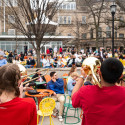Type of celebration
Silver Buckle Press, the working museum of printing history, caps its silver anniversary year with wood in the form of a new book. “Specimen Book of Wood Type” thoroughly catalogs the museum’s more than 80 wood-type holdings.
  Top, the cover of “Specimen Book of Wood Type,” which thoroughly catalogs the museum’s more than 80 wood type holdings. Bottom, a close view of wood-type letters, in this case 20 line Teutonic Extended. In addition to wood type, the Silver Buckle Press includes a complete 19th-century print shop, an 1840 Albion handpress and many other items used to set type in bygone eras. |
|
Details “Specimen Book of Wood Type” is available for $75 through Silver Buckle Press, 236 Memorial Library, 728 State St., Madison, 53706, 263-4929. |
The university purchased the collection that became Silver Buckle from the estate of Robert Shaftoe, former Ford Motor Company art director.
The Silver Buckle moniker comes from a nursery rhyme: “Bobby Shaftoe went to sea, Silver buckles on his knees.” When the press opened in 1973, it occupied digs on the first floor of Helen C. White Hall as part of the UW–Madison General Library System.
In 1994, the press moved to 236 Memorial Library. Today the collection includes a complete 19th-century print shop, an 1840 Albion handpress, a newspaper proof press, hundreds of decorative borders, ornaments, cuts, electrotypes and more, in addition to wood type.
According to SBP curator Tracy Honn, wood type was made from end-grain hardwoods such as maple. Letters were produced with a pantographic router, but most also required further hand finishing. That hand work, plus nicks and scratches that occur through use, give wood type its characteristic weathered appearance, she says.
“Wood type was an American invention and important Wisconsin industry during the last century. Lithography made most wood-type printing obsolete by the turn of the 20th century, although types designed for wood are still seen in digitized fonts today. The boldly exuberant style is associated with rodeo and circus posters, as well as the classic ‘Wanted’ poster,” Honn says.
SBP publishes books and broadsides, and works with UW–Madison and the larger community to offer tours and educational opportunities. To learn more about printing history, visit: http://www.library.wisc.edu/libraries/SBP/.



